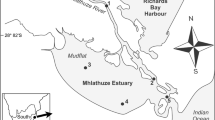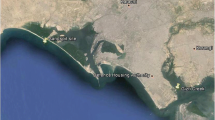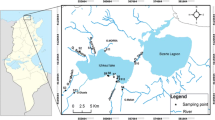Abstract
Heavy metal inputs to coastal Alaska ecosystems are driven by sediment loads from glacial meltwater and river outflows. This study characterized the spatial distribution of 16 major and trace metals in five strata in Kachemak Bay, as well as sediment total organic carbon content and grain size. Homer Harbor, a shallow harbor within the study area, contained elevated metal concentrations compared to the other strata. Outside the harbor, several metals, including Cr, Ni, Pb, and Zn, were significantly higher in the eastern strata than in the western portions of the bay. The opposite was true for a few other metals, such as Hg. However, most metal concentrations were below the National Oceanic and Atmospheric Administration’s sediment quality guidelines for sediment toxicity to benthic communities.





Similar content being viewed by others
References
ADEC, Alaska Depart. of Environmental Conservation (2008). Places of Refuge for the Cook Inlet Subarea. Alaska Dept. of Environmental Conservation, Division of Spill Prevention and Response. http://www.dec.state.ak.us/spar/perp/cookinletpor/index.htm.
ADF&G, Alaska Depart. of Fish and Game (1998). Final Environmental Impact Statement/Final Management Plan. Kachemak Bay National Estuarine Research Reserve. Online at www.habitat.adfg.state.ak.us.
AMAP, Arctic Monitoring Assessment Program. (2005). Heavy Metals in the Arctic. Arctic Monitoring and Assessment Program (AMAP), Oslo, Norway. xvi +265 pp. (first published as electronic document in 2004). www.amap.no.
Apeti, D. A., Hartwell, S. I., Johnson, W. E., & Lauenstein, G. G. (2012). National status and trends bioeffects program: field methods. NOAA National Centers for Coastal Ocean Science, Center for Coastal Monitoring and Assessment. NOAA NCCOS Technical Memorandum 135. Silver Spring, MD. 52pp.
Burrel, D. C. (1979). Distribution and dynamics of heavy metals in Alaskan Shelf environments subject to oil development. In Environmental assessment of the Alaskan Continental Shelf. Final Report Volume V. Receptors—microbiology contaminant Baselines (pp. 326–546). U.S. DOC NOAA. Boulder, CO.
COE, U.S. Army Corps of Engineers (2007). Homer Small Boat Harbor and Coast Guard Dock Homer, Alaska. U.S. Army Corps of Engineers Alaska District. Homer, Alaska, August, 2007.
COE, U.S. Army Corps of Engineers (2009). Sediment evaluation framework for the Pacific Northwest. U.S. Corps of Engineers-Portland District, Seattle District. May 2009.
EPA, U.S. Environmental protection Agency (1995). Environmental Monitoring and Assessment Program (EMAP): Laboratory Methods Manual—Estuaries, Volume 1: Biological and Physical Analyses. United States Environmental Protection Agency, Office of Research and Development, Narragansett, RI. EPA/620/R-95/008.
EPA, U.S. Environmental protection Agency (2005). Coastal condition report for Alaska, Hawaii and island territories. National Coastal Condition Report II. pp. 215–246.
Exxon Valdez Oil Spill Trustee Council (2002). Update on injured resources and services. Exxon Valdez Oil Spill Restoration Plan. Anchorage, Alaska.
Flores, R.M., Stricker, G.D. & Kinney, S.A. (2004). Alaska, Coal Resources, and Coalbed Methane Potential. Department of Interior, U.S. Geological Survey, U.S. DDS-77, Denver Colorado.
Forstner, U., & Witmann, G. T. W. (1981). Metal pollution in the aquatic environment (p. 486). New York: Springer – Verlag Ed.
Hartwell, S. I., & Hameedi, J. (2007). Magnitude and extent of contaminated sediment and toxicity in Chesapeake Bay. NOAA Technical Memorandum NOS/NCCOS/CCMA 47. National Oceanic and Atmospheric Administration, National Ocean Service, Silver Spring, MD, 234pp.
Heimbuch, D., Wilson, H., Seibel, J., & Weisberg, S. (1995). R-EMAP data analysis approach for estimating the portion of area that is subnominal. Report prepared for U.S. EPA, Research Triangle Park, NC, p. 22.
KBNERR, Kachemak Bay National Estuarine Research Reserve (2001). Kachemak bay ecological characterization. CD-ROM. NOAA/CSC/20017-CD. Charlston, SC.
Kimbrough, K. L., & Lauenstein, G. G. (2006). Trace metal analytical methods of the national status and trends program: 2000–2006. US Dept. Comm., NOAA Technical Memorandum 29, NOS NCCOS, Silver Spring, MD.
Kimbrough, K. L, Johnson, W. E., Lauenstein, G. G., Christensen, J. D., & Apeti, D. A. (2008). An assessment of two decades of contaminant monitoring in the Nation’s Coastal Zone. Silver Spring: NOAA Technical Memorandum, NOS NCCOS 74. 105pp.
Long, E. R., & Morgan, L. G. (1990). The potential for biological effects of sediment-sorbed contaminants tested in the national status and trends program. NOAA Tech. Memo NOS OMA 52. Seattle: WANOAA. 175pp.
Long, E. R., MacDonald, D. D., Smith, S. L., & Calder, F. D. (1995). Incidence of adverse biological effects within ranges of chemical concentrations in marine and estuarine sediments. Environmental Management, 19, 81–97.
Long, E. R., Robertson, A., Wolfe, D. A., Hameedi, J., & Sloane, G. M. (1996). Estimates of the spatial extent of sediment toxicity in major U.S. estuaries. Environmental Science & Technology, 30(12), 3585–3592.
MacDonald, D. D. (1994). Approach to the assessment of sediment quality in Florida coastal waters. vol. 2—application of the sediment quality assessment guidelines. Tallahassee: Florida Department of Environmental Protection, Office of Water Policy.
O’Connor, T. P. (2002). National distribution of chemical concentrations in mussels and oysters in the USA. Martine Environmental Research, 53, 117–143.
Robertson, D. E., & Abel, K. H. (1990). Natural distribution and environmental background of trace heavy metals in Alaskan shelf and estuarine areas. In Outer continental shelf environmental assessment program. Final Report Volume 69. Anchorage.
Saupe, S. M., Gendron, J., & Dasher, D. (2005). The condition of southcentral alaska coastal bays and estuaries. A statistical summary for the national coastal assessment program Alaska Department of Environmental Conservation, MARCH 15, 2006.
Schropp, S. J., Lewis, F. G., Windom, H. L., Ryan, J. D., Calder, F. D., & Burney, L. C. (1990). Interpretation of metal concentrations estuarine sediments of Florida using aluminum as a reference element. Estuaries, 13(3), 227–235.
Shepard, F. P. (1954). Nomenclature based on sand-silt-clay ratios. Journal of Sedimentary Petrology, 24(3), 151–158.
Szarzi, N. J., Kerkvliet, C. M., Stock, C. E., & Booz, M. D. (2007). Recreational fisheries in the lower Cook Inlet management area, 2005–2007, with updates for 2004. Alaska Department of Fish and Game, Division of Sport Fish and Commercial Fish, Fishery Management Report No. 07-55, Anchorage Alaska.
Windom, H. L., Schropp, S. J., Calder, F. D., Ryan, J. D., Smith, R. G., Jr., Burney, L. C., et al. (1989). Natural trace metal concentrations in estuarine and coastal marine sediments of the southeastern United States. Environmental Science and Technology, 23, 314–320.
Acknowledgments
The authors wish to acknowledge the North Pacific Research Board for major funding support. The Cook Inlet Regional Citizens Advisory Council also provided funding to support field work. The Kachemak Bay National Estuarine Research Reserve and Kasitsna Bay Lab provided logistical support. Capt. John Crosbie and Everett Anderson worked tirelessly aboard the vessel Columbia. Mark Janes and Tim Robertson of Nuka Research also assisted in the field work. We thank Kevin McMahon for his constructive comments.
Author information
Authors and Affiliations
Corresponding author
Rights and permissions
About this article
Cite this article
Apeti, D.A., Hartwell, I.S. Baseline assessment of heavy metal concentrations in surficial sediment from Kachemak Bay, Alaska. Environ Monit Assess 187, 4106 (2015). https://doi.org/10.1007/s10661-014-4106-x
Received:
Accepted:
Published:
DOI: https://doi.org/10.1007/s10661-014-4106-x




